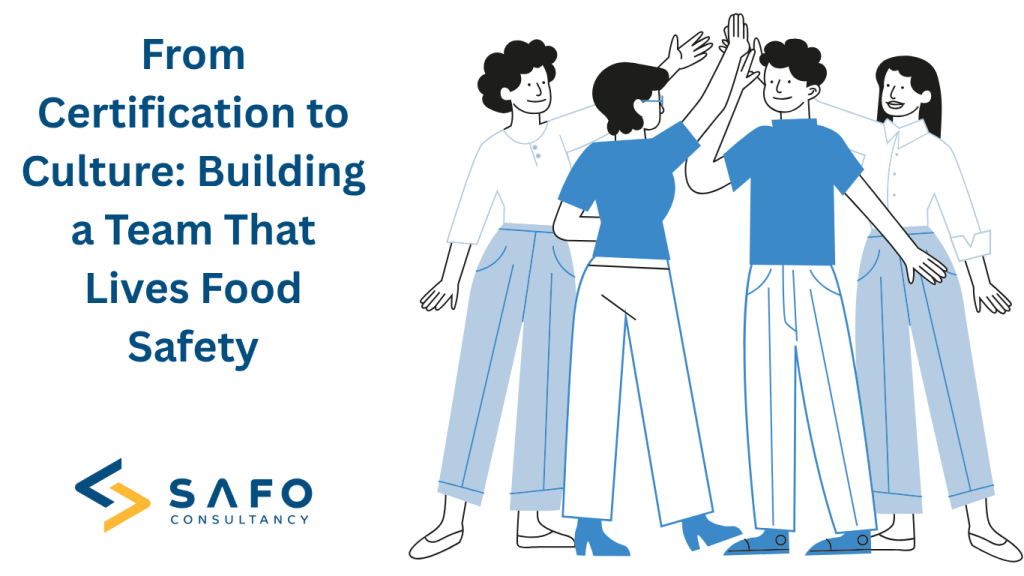
Food safety doesn’t stop at certification. While achieving a standard like ISO 22000 or BRCGS is commendable, it’s just the starting point. The real success lies in transforming compliance into a living, breathing food safety culture—one where every team member sees food safety not as a task, but as a core value.
Let’s explore how your food business can move from certification to culture, and build a team that lives food safety every day.
1. Understand the Difference: Certification vs. Culture
Certification is a structured process with defined requirements, documents, audits, and timelines. Culture, on the other hand, is about behavior, mindset, and consistency.
✅ Certification = Compliance
✅ Culture = Commitment
A food safety culture ensures that even when no one is watching, your employees do the right thing. That mindset is priceless in preventing contamination, recalls, or reputational damage.
2. Lead from the Top
A strong food safety culture begins with leadership. When senior management prioritizes food safety in their language, actions, and decisions, it sends a clear message across all levels.
What leaders can do:
-
Include food safety in strategic meetings
-
Attend internal food safety training sessions
-
Reward teams that demonstrate food safety best practices
-
Allocate sufficient budgets for safety-related improvements
3. Train for Awareness, Not Just Knowledge
Training isn’t just about ticking boxes or passing assessments. It should inspire employees to care about food safety.
Make training:
-
Practical: Use real-life case studies from your own operations
-
Interactive: Encourage questions, discussions, and hands-on sessions
-
Ongoing: Reinforce messages regularly with refreshers and toolbox talks
Remember, awareness builds responsibility, and responsible employees reduce risks.
4. Empower Employees to Speak Up
A team that lives food safety must feel safe to report risks, mistakes, or violations—without fear. This is known as a just culture.
Encourage:
-
Anonymous reporting systems
-
Open-door policies
-
Recognition of proactive reporting
-
Team discussions after incidents (not blame sessions)
When your team sees their input leads to action, they’ll feel truly engaged.
5. Celebrate Food Safety Wins
Food safety efforts often go unnoticed unless something goes wrong. Flip the script—celebrate when things go right!
Ideas to reward and recognize:
-
Monthly food safety champion awards
-
Wall of fame for hygiene compliance
-
Team shout-outs during morning briefings
-
Small incentives for SOP compliance
Positive reinforcement keeps motivation high and reminds everyone that food safety is everyone’s job.
6. Integrate Food Safety into Daily Operations
Culture becomes part of your DNA when food safety is woven into every process—not treated as an isolated department.
How to integrate:
-
Include food safety checks in daily production schedules
-
Involve cross-functional teams in internal audits
-
Update SOPs with input from the actual users
-
Set KPIs related to food safety for every team, not just QA
7. Measure and Improve Continuously
You can’t improve what you don’t measure. Assess your food safety culture regularly using tools like:
-
Culture assessment surveys
-
Internal audits focused on behavior
-
Employee feedback forms
-
Incident and near-miss tracking
Use the results to identify gaps and make informed improvements.
Final Thoughts
Achieving certification is a milestone, but building a food safety culture is a journey. It requires leadership, teamwork, trust, and continuous engagement.
When food safety becomes a shared value and not just a regulation, your organization won’t just comply—it will thrive.
🔐 Food safety isn’t just a standard—it’s a culture. And culture starts with people.
